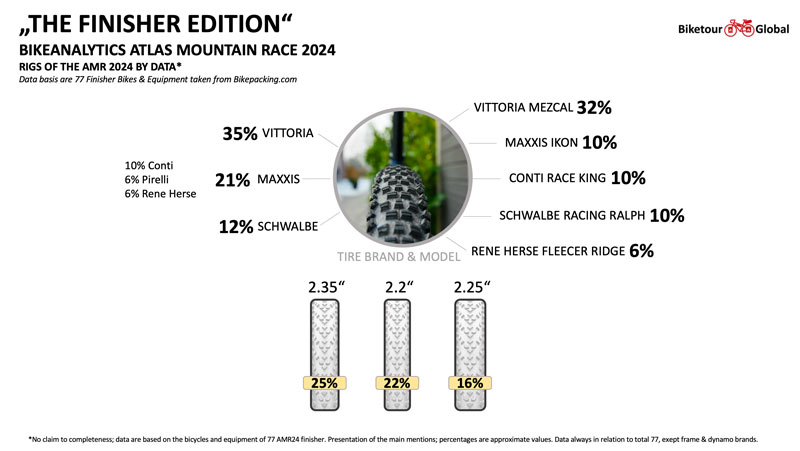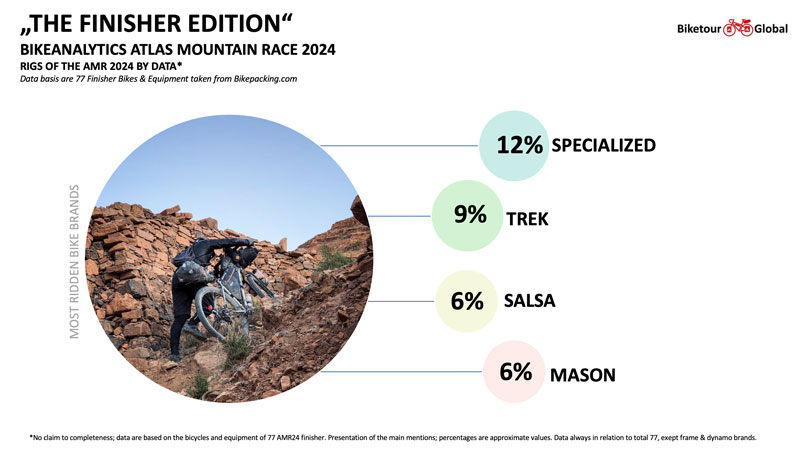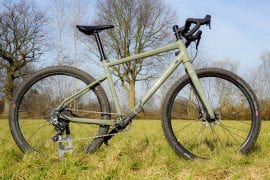For many years I have been analysing the bikes and equipment of participants in some of the larger bikepacking races. The basis for this are the “Rigs of…” articles from Bikepacking.com, where some participants introduce and briefly describe their bikes.
Two weeks ago I introduced you to Bikeanalytics Atlas Mountain Race 2024 and analysed 109 bikes. This data is intended as information and categorisation so that you can see very clearly what material and equipment is used at such events.
However, some of you also asked me to analyse the data of those who make it to the finish line. I have now done that.
Of the 137 finishers of the Atlas Mountain Race 2024, I was able to equalise 77 bikes in the Bikepacking.com article “Rigs of Atlas Mountain Race”(Part 1/Part2). This corresponds to 71% of the bikes from the Bikeanalytics article before the start.
Basically, in races of this type, you should keep in mind that the bike and the equipment are only one part of a successful participation. The other part is mental strength, physical fitness, health and, quite simply, luck.
Before we get into the details, here is the original data of the bikes of all those at the start:

Bikeanalytics Finisher Atlas Mountain Race 2024
As in the large analysis of all starters, the majority of finishers rode bikes with carbon frames. Followed by steel and titanium.
However, according to the data, more participants crossed the finish line with steel frames than with carbon frames. The proportion of steel frames was 17% in the overall field, and that of carbon at 60%. Titanium also lost some ground (-2 percentage points).

There was also a question about suspension. 87% of the finishers were riding with a suspension fork (compared to 85% in the first analysis). And 26% completed the race on a fully.

There were no differences when it came to handlebars: 79% rode with a flat bar, 21 with a drop bar. However, the percentage of those who rode with a handlebar attachment is slightly higher (75%) than the aero percentage of the starter group (71%).

And there are also no differences in the use of hub dynamos. The distribution in the field is exactly the same as for the starter group. Only the proportion of SON hub dynamos among the finishers is higher at 91% (compared to 86%).

SRAM was able to slightly increase its share in the finisher field: 57% of the bikes at the finish were fitted with SRAM. In terms of the frequency of gear models, however, Shimano XT was slightly ahead of SRAM GX at the finish line. And 5% (compared to 8% at the start) of the gears at the finish were SRAM Transmission.

39% were travelling electronically, slightly more than at the start (37%).
There were also slight shifts in the drivetrain: the majority of finishers were riding with 12-speed (82% vs. 79%). In terms of cassette size, the 10-52 remains the most frequently used cassette. This also has to do with SRAM as the preferred gear system.

Without any major changes, 1x remains the first choice up front to reach the finish line. Combined with a 32t crankset (26% vs 22%).
Almost all finishers were on 29 inch wheels. Only 3% with 700cc and 3% with 27.5 inch. The majority of 62% crossed the finish line on carbon rims, 27% with aluminium rims.

In terms of tyres, it seems that all Mezcal made it to the coast. Compared to the large evaluation group, however, Schwalbe overtook Conti at the finish line to take third place. Everything remained the same for the tyre models, with Mezcal ahead of Ikon and Race King.

I also recorded the tyre widths: 25% of the finishers, as well as the starters, had 2.35″ wide tyres.
If you look specifically at bike brands, you obviously have a good chance of finishing on a Specialized, followed by Trek and Salsa. Mason was also a frequent finisher. However, Canyon no longer appears on this list, as only 3 of the 8 Canyons at the start made it to the finish line by my count.

And there was also a shift in the panniers: Tailfin has now taken the lead here with 39% of finishers, ahead of Apidura with 38% and Revelate with 17%. This probably also has to do with the fact that many strong riders were travelling with Tailfin, some of them as Tailfin R&D riders. In any case, I’m already looking forward to when these bags are available and can be tested.

THE AMR Bike 2024
In summary, it can be said that – if you believe in it – a winning AMR bike has a carbon frame, suspension fork, 29-inch wheels with carbon rims, plus Vittoria Mezcal tyres in 2.35″ width, with a mechanical 12-speed SRAM drivetrain (presumably GX) with a 10-52 cassette and a 32-speed crankset at the front. The handlebars are a flat bar with a handlebar attachment. The panniers are from Tailfin and it’s probably a Specialised.
So now nothing stands in the way of the finish!





